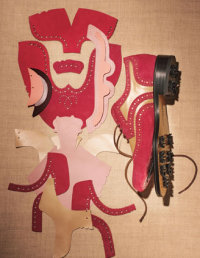And that venture might have made it – if there was a shoe manufacturing infrastructure left to support the effort. The lack of that infrastructure ultimately doomed the company’s US manufacturing strategy – last month, the Florida factory was shuttered, and Shaffer moved Otabo’s manufacturing to China.
Supply Base is Gone
 Naturally, when final manufacturing operations move out of the US or Europe, the supporting vendor base either moves to where the business is or simply gives up. Naturally, when final manufacturing operations move out of the US or Europe, the supporting vendor base either moves to where the business is or simply gives up.
This was in large measure the source of Otabo’s US demise, exacerbated by the fact that as a niche custom-producer its volumes were low.
For example, the company required a special type of outsole, a component in the bottom of the shoe. While it was able to source the product for awhile from one US supplier, Otabo recently got some bad news – the supplier would no longer make the product, as the demand didn’t justify the costs.
The Wall Street Journal quotes, Thomas Dieckhaus, one of the owners of the supplier, Meramec Group Inc. in Sullivan, Mo., as saying that "One of the biggest challenges for the footwear manufacturers that remain in the U.S. is sourcing components. It limits the materials they can use -- and therefore influences the type of footwear that gets manufactured."
Otabo also ran into trouble sourcing eyelets for the shoes. They wanted the company name printed on the metal components, but couldn’t find a US supplier that was willing to produce the product for them at the relatively small order volumes.
Shaffer, in the Wall Street Journal, contrasts that to what’s available in China: "There are places in China where you have city blocks made up of nothing but makers of shoe materials," he said. "You can buy 10,000 laces or 10 laces."
The poor supporting infrastructure went beyond just component suppliers. As the industry declines, finding technicians to service specialized shoe manufacturing equipment and parts to keep them going also becomes a huge challenge.
In 2005, a manufacturing trade magazine named Otabo "Progressive Manufacturer of the Year.” Around the same time, then Florida Governor Jeb Bush visited the factory to recognize its efforts. All for naught now.
“I really thought I could show how this industry had a future here," said Shaffer as he watched his Florida factory being dismantled. Some of it is going to China; other machines are available on Craig’s List.
What’s your take on the Otabo story? What other industries are seeing any supporting infrastructure go away, dooming the remaining manufacturers? What, if anything, should be done about it? Let us know your thoughts at the Feedback button below.
|